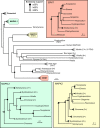Not your Mother's MAPKs: Apicomplexan MAPK function in daughter cell budding
- PMID: 36227859
- PMCID: PMC9560070
- DOI: 10.1371/journal.ppat.1010849
Not your Mother's MAPKs: Apicomplexan MAPK function in daughter cell budding
Abstract
Reversible phosphorylation by protein kinases is one of the core mechanisms by which biological signals are propagated and processed. Mitogen-activated protein kinases, or MAPKs, are conserved throughout eukaryotes where they regulate cell cycle, development, and stress response. Here, we review advances in our understanding of the function and biochemistry of MAPK signaling in apicomplexan parasites. As expected for well-conserved signaling modules, MAPKs have been found to have multiple essential roles regulating both Toxoplasma tachyzoite replication and sexual differentiation in Plasmodium. However, apicomplexan MAPK signaling is notable for the lack of the canonical kinase cascade that normally regulates the networks, and therefore must be regulated by a distinct mechanism. We highlight what few regulatory relationships have been established to date, and discuss the challenges to the field in elucidating the complete MAPK signaling networks in these parasites.
Conflict of interest statement
The authors have declared that no competing interests exist.
Figures




References
Publication types
MeSH terms
Substances
Grants and funding
LinkOut - more resources
Full Text Sources
Research Materials

